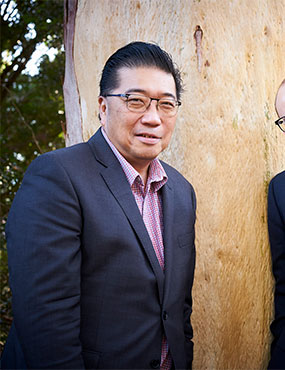Pioneering a new bronchial procedure
In 2019, Macquarie University Health’s interventional pulmonology specialists performed the first clinical bronchial thermal vapour ablation procedure for COPD in Australia.

New bronchial procedure for COPD
Interventional pulmonologist Professor Alvin Ing performed Australia’s first bronchoscopic thermal vapour ablation (BTVA) procedure in a clinical setting at Macquarie University Hospital in 2019. BTVA is a recently developed method of endoscopic lung volume reduction (ELVR).
Lung volume reduction is desirable in chronic obstructive pulmonary disease (COPD) patients with emphysema who have hyperinflated lungs and gas trapping that cause breathlessness.
Until recently, ELVR was only available with endobronchial valves. Whether a patient was suitable for this procedure was determined largely by the presence or absence of collateral ventilation, or the integrity or lack of normal lung structures (fissures) that define lobes of the lungs.
COPD patients with a lack of collateral ventilation of the targeted lobe show a good response to ELVR with endobronchial valves. However, for patients with collateral ventilation, there have been no options available to achieve ELVR. At least 50 per cent of patients with severe COPD fall into this category, and BTVA now offers a treatment strategy for this group.
“BTVA addresses an unmet medical need in the treatment of COPD patients with emphysema,” explained Professor Alvin Ing, Clinical Program Head for the Cardiovascular and Respiratory Program at Macquarie University Health, and a pioneer of ELVR who performed the first bronchial thermoplasty procedure in NSW for patients with refractory asthma.
“BTVA is the next step in developing and delivering minimally invasive bronchoscopic therapies to induce sustained lung volume reduction.” BTVA involves the targeted delivery of steam to the diseased sections of lung, while preserving healthy sections. Patients have two treatment sessions three months apart.
Outcomes are measured using lung function measurements, validated symptoms and quality of life scores, and a six-minute walk test taken three and 12 months after the second treatment.
HRCT imaging and CT–SPECT differential V/Q scanning are also used to assess lung volume reduction and changes in ventilation and perfusion.
The Macquarie University Health cases are the first to be enrolled in a multi-centre national registry investigating the efficacy and safety of thermal ablation as a method of achieving ELVR in severe COPD patients.
The procedure is now available through Macquarie University Health Respiratory and Sleep with Professor Alvin Ing, Associate Professor Jonathan Williamson, Dr Tajalli Saghaie and Professor Martin Phillips.